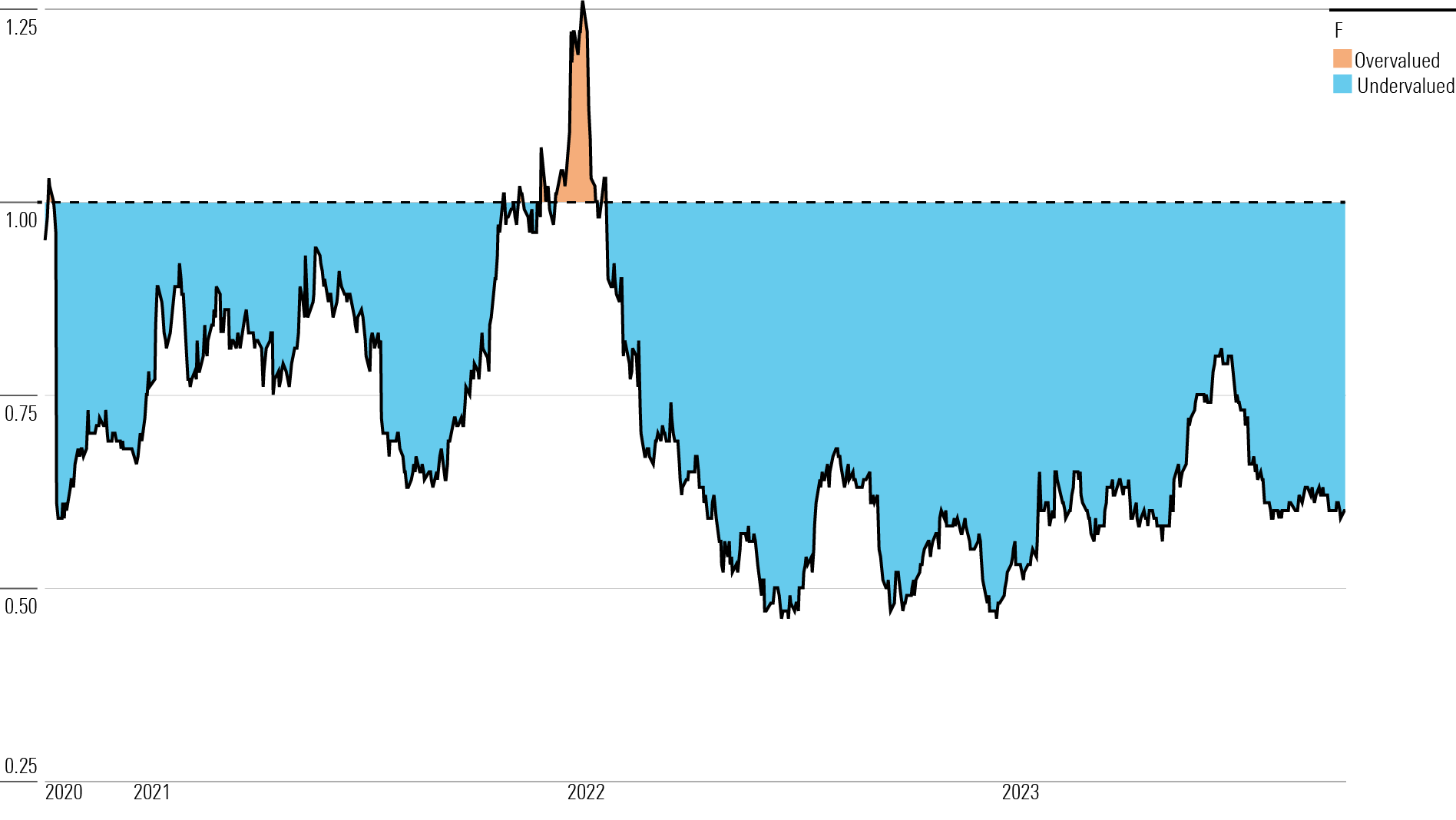Going Into Earnings, Is Ford Stock a Buy, a Sell, or Fairly Valued?
With ongoing strikes, here’s what we’ll be watching for in Q3 earnings.

Ford Motor F stock is up 8% over the last 12 months. Ahead of its third-quarter earnings report, here is Morningstar’s take on what to look for in Ford’s earnings, as well as the outlook for its stock.
Key Morningstar Metrics for Ford Motor
- Fair Value Estimate: $20.00
- Morningstar Rating: 4 stars
- Morningstar Economic Moat Rating: None
- Morningstar Uncertainty Rating: High
Ford Motor Earnings Date
Oct. 26, after the market close.
What to Watch for In Ford’s Q3 Earnings
- With the United Automobile Workers strike so prevalent, third-quarter results seem far less important than normal. Results should be solid since most strike damage will be in the fourth quarter, but there will probably be at least a $100 million hit this quarter.
- The biggest thing now is a liquidity update. As of June 30, Ford had automotive cash of $29.8 billion, and including the $4 billion credit line it opened in late August, it had total liquidity of about $51 billion. The key issue is what those numbers were either on Sept. 30 or as of the date it reports. Liquidity matters because if Ford decides to hold out against the union (which it appears to be doing), then it’s just math to see whether the company or the UAW strike fund goes broke first.
- We expect Ford will lower or withdraw the full-year guidance given with its second-quarter results because of the strike. The UAW currently appears to be winning because the strike has automakers raising their offers.
Ford Motor Stock Price
Fair Value Estimate for Ford Stock
With its 4-star rating, we believe Ford’s stock is undervalued compared with our long-term fair value estimate.
We are raising our fair value estimate to $20 per share from $19. The change is from time value of money and 2023 revenue progressing ahead of our prior model. We now model about 11% more automotive revenue over our five-year explicit forecast period.
At Ford’s May 2023 analyst day, the company announced a 2024 capital expenditure projection of $10 billion-$11 billion, up from as much as $9 billion in 2023. Before May, we were modeling $8 billion-$9 billion in capital expenditure annually for 2024-27, but since May we model $11 billion in 2024 and $10 billion each year for 2025-27. This 20.6% increase assumes capital expenditure after 2024 will remain close to 2024 levels to capture the incremental spending needed in EVs and software as Ford transforms itself from a traditional automaker.
Our compound annual automotive revenue growth rate is nearly 4%, up from about 1.5%. We model capital expenditure at about 6% of automotive revenue on average, totaling $50 billion for 2023-27. We value Ford Credit at its 2022 year-end book value of $11.9 billion. We see uncertainty as to when improvement occurs, as variables like commodity and materials costs, interest rates, and the semiconductor shortage are mostly beyond management’s control.
Read more about Ford’s fair value estimate.
Ford Historical Price/Fair Value Ratio

Economic Moat Rating
Ford does not have a moat, and we do not expect that to change. Vehicle manufacturing is a very capital-intensive business, but barriers to entry are not as high as they were in the past. The industry is already full of strong competition, so it is nearly impossible for one firm to gain a durable advantage. Foreign automakers from China and India may soon enter developed markets such as the United States, and South Korea’s Hyundai and Kia have become formidable competitors, as has Tesla TSLA.
Furthermore, the industry is so cyclical that in bad times, even the best automakers cannot avoid large declines in return on invested capital and profit. Cost-cutting helps ease the pain, but it does not restore all lost profit.
Read more about Ford’s moat rating.
Risk and Uncertainty
Our Uncertainty Rating for Ford is High. The semiconductor shortage brings more uncertainty as to recovery timing. Ford is spending $50 billion across 2022-26 betting consumers will switch to electric vehicles, and so much capital will be wasted if that adoption is too slow or if regulations change due to not enough consumers making the switch. Barriers to entry are declining as a growing global market reduces fixed costs as a percentage of sales for new entrants. The company operates in a very cyclical industry, and there is massive uncertainty as to the timing and magnitude of demand recovery following COVID-19.
Macroeconomic conditions, rising interest rates, commodity prices, and trade agreement changes in key markets like the U.S., Europe, and China can quickly derail management’s plans and guidance, while significant disruption is on the horizon as vehicles become more high-tech and autonomous. Work stoppages are an inherent risk in contract years, but Ford’s union relationships historically have been better than those of General Motors GM.
One of the largest environmental, social, and governance risks we see with Ford is increasing regulatory scrutiny on combustion vehicles. But we think management is planning for the change, and EVs such as the Mach-E and F-150 Lightning show Ford is serious about switching away from combustion.
Read more about Ford’s risk and uncertainty.
F Bulls Say
- Ford’s turnaround will take lots of time due to many restructuring projects around the world, but so far the international business seems to be getting better.
- Ford is focusing its investments where it gets the best return, which is why we think mostly exiting North American car segments and production in South America is the right move.
- Ford has tried to remove some administrative layers, and we like CEO Jim Farley’s aggressive moves into EVs, which the company was slow to do in the past.
F Bears Say
- The auto industry is very cyclical, and until recently, Detroit automakers had been losing significant U.S. market share to foreign automakers for years.
- Long-term profitability could be hindered by unions, which traditionally have wanted their share of the pie. The nonunionized import automakers in the U.S. do not have this problem.
- Ford’s stock can sell off heavily on macroeconomic fears, even if the company itself is doing well. Furthermore, it takes significant investment to fund growth in the auto industry, which limits potential margin expansion.
This article was compiled by Brendan Donahue.
The author or authors do not own shares in any securities mentioned in this article. Find out about Morningstar’s editorial policies.

/s3.amazonaws.com/arc-authors/morningstar/222a1c0d-911c-4064-ac93-f9d4516d0a06.jpg)
/cloudfront-us-east-1.images.arcpublishing.com/morningstar/6A6R4SGLDNGMXHAH3K2CIQTF3Q.jpg)
/cloudfront-us-east-1.images.arcpublishing.com/morningstar/PVJSLSCNFRF7DGSEJSCWXZHDFQ.jpg)
/cloudfront-us-east-1.images.arcpublishing.com/morningstar/F5UMFVVKMVFRPGGUY4LONIK6OY.jpg)
:quality(80)/s3.amazonaws.com/arc-authors/morningstar/222a1c0d-911c-4064-ac93-f9d4516d0a06.jpg)